Communication in Health and Social Care: A Comprehensive Analysis
VerifiedAdded on 2024/05/17
|12
|4262
|128
AI Summary
This assignment delves into the crucial role of communication in health and social care settings. It explores various communication theories and methods, highlighting the importance of effective interpersonal communication, cultural sensitivity, and the influence of values. The assignment also examines the impact of organizational systems and policies on communication practices, emphasizing the need for clear communication channels and ethical considerations. Furthermore, it analyzes the benefits and legal implications of utilizing ICT software in health and social care, showcasing its potential to enhance service delivery and patient care.
Contribute Materials
Your contribution can guide someone’s learning journey. Share your
documents today.
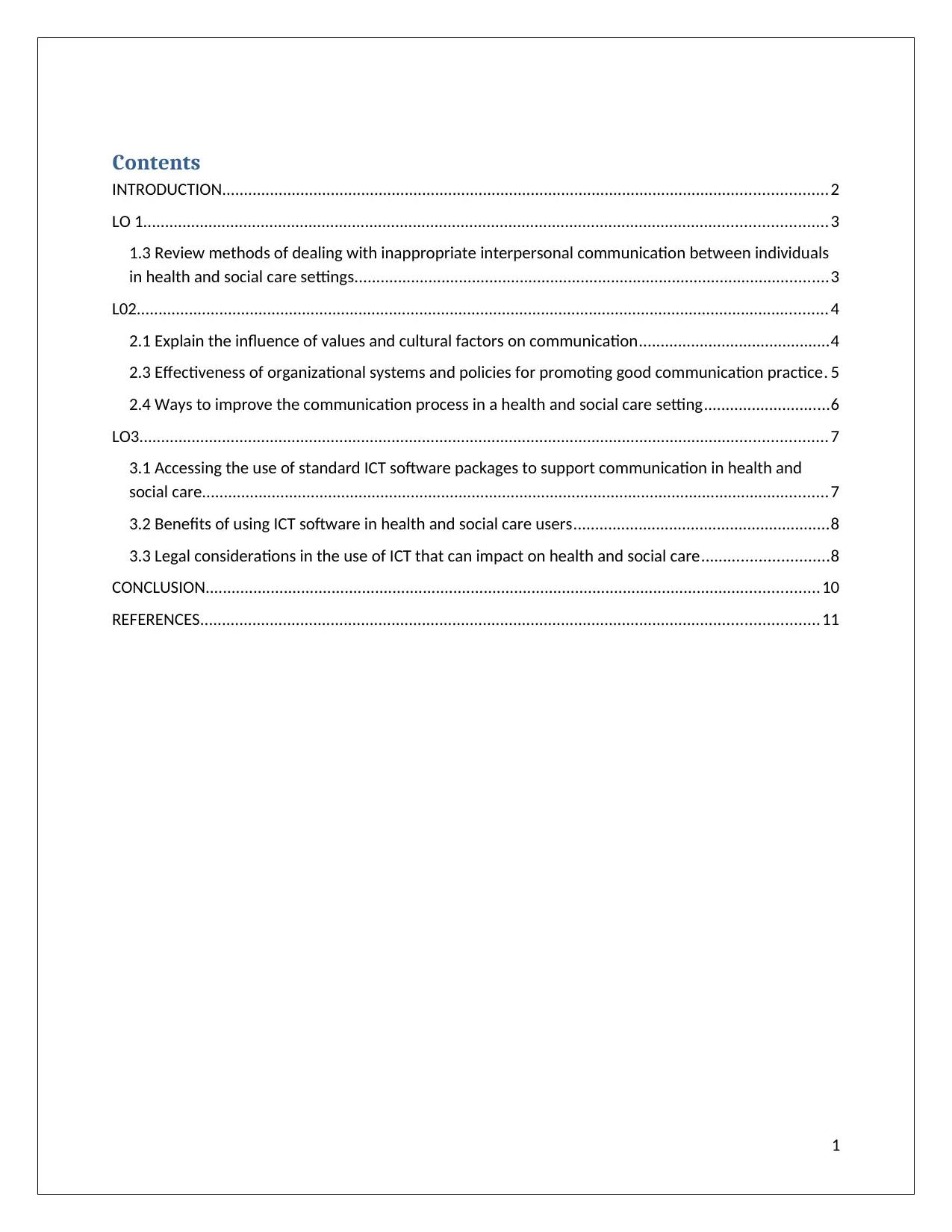
Contents
INTRODUCTION...........................................................................................................................................2
LO 1.............................................................................................................................................................3
1.3 Review methods of dealing with inappropriate interpersonal communication between individuals
in health and social care settings.............................................................................................................3
L02...............................................................................................................................................................4
2.1 Explain the influence of values and cultural factors on communication............................................4
2.3 Effectiveness of organizational systems and policies for promoting good communication practice. 5
2.4 Ways to improve the communication process in a health and social care setting.............................6
LO3..............................................................................................................................................................7
3.1 Accessing the use of standard ICT software packages to support communication in health and
social care................................................................................................................................................7
3.2 Benefits of using ICT software in health and social care users...........................................................8
3.3 Legal considerations in the use of ICT that can impact on health and social care.............................8
CONCLUSION.............................................................................................................................................10
REFERENCES..............................................................................................................................................11
1
INTRODUCTION...........................................................................................................................................2
LO 1.............................................................................................................................................................3
1.3 Review methods of dealing with inappropriate interpersonal communication between individuals
in health and social care settings.............................................................................................................3
L02...............................................................................................................................................................4
2.1 Explain the influence of values and cultural factors on communication............................................4
2.3 Effectiveness of organizational systems and policies for promoting good communication practice. 5
2.4 Ways to improve the communication process in a health and social care setting.............................6
LO3..............................................................................................................................................................7
3.1 Accessing the use of standard ICT software packages to support communication in health and
social care................................................................................................................................................7
3.2 Benefits of using ICT software in health and social care users...........................................................8
3.3 Legal considerations in the use of ICT that can impact on health and social care.............................8
CONCLUSION.............................................................................................................................................10
REFERENCES..............................................................................................................................................11
1
Secure Best Marks with AI Grader
Need help grading? Try our AI Grader for instant feedback on your assignments.
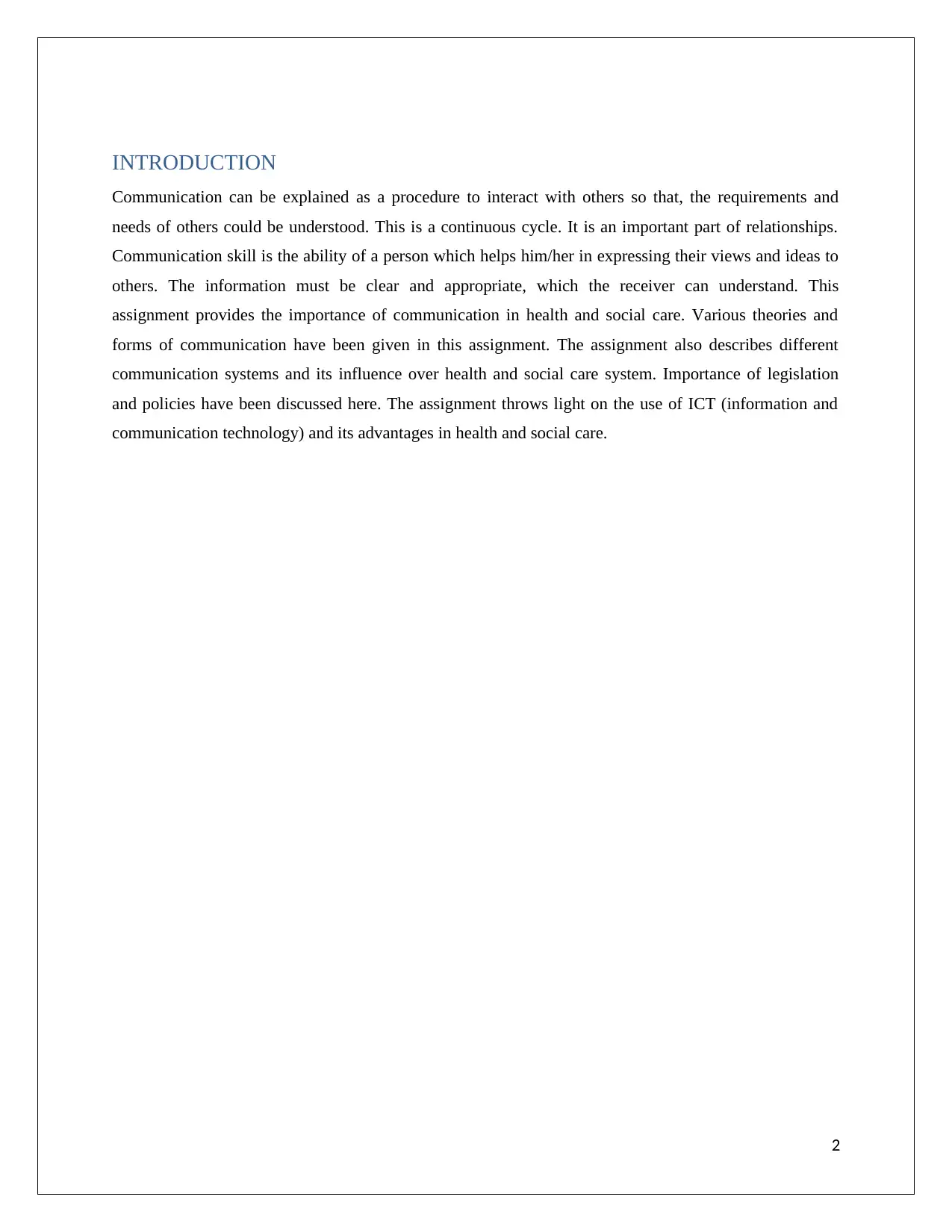
INTRODUCTION
Communication can be explained as a procedure to interact with others so that, the requirements and
needs of others could be understood. This is a continuous cycle. It is an important part of relationships.
Communication skill is the ability of a person which helps him/her in expressing their views and ideas to
others. The information must be clear and appropriate, which the receiver can understand. This
assignment provides the importance of communication in health and social care. Various theories and
forms of communication have been given in this assignment. The assignment also describes different
communication systems and its influence over health and social care system. Importance of legislation
and policies have been discussed here. The assignment throws light on the use of ICT (information and
communication technology) and its advantages in health and social care.
2
Communication can be explained as a procedure to interact with others so that, the requirements and
needs of others could be understood. This is a continuous cycle. It is an important part of relationships.
Communication skill is the ability of a person which helps him/her in expressing their views and ideas to
others. The information must be clear and appropriate, which the receiver can understand. This
assignment provides the importance of communication in health and social care. Various theories and
forms of communication have been given in this assignment. The assignment also describes different
communication systems and its influence over health and social care system. Importance of legislation
and policies have been discussed here. The assignment throws light on the use of ICT (information and
communication technology) and its advantages in health and social care.
2
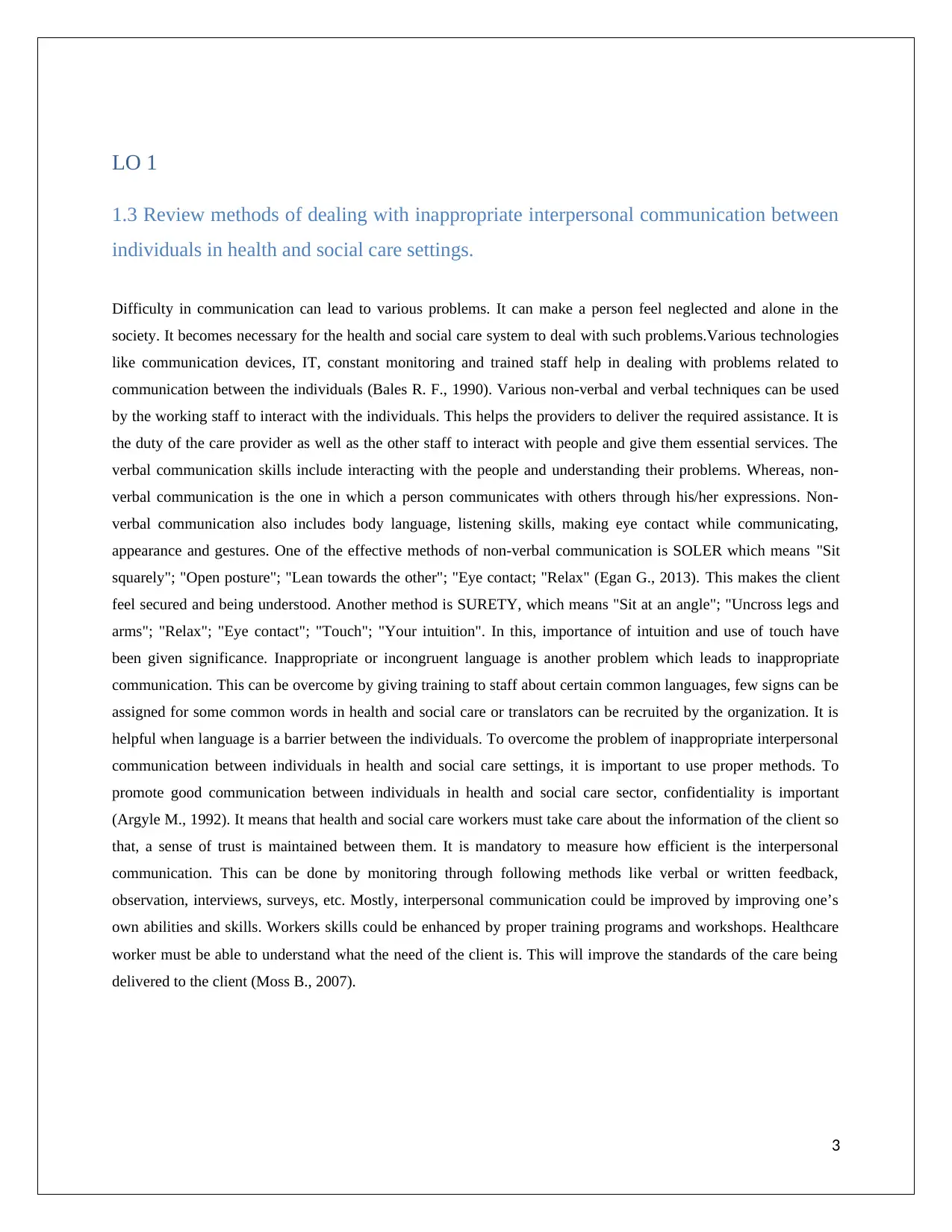
LO 1
1.3 Review methods of dealing with inappropriate interpersonal communication between
individuals in health and social care settings.
Difficulty in communication can lead to various problems. It can make a person feel neglected and alone in the
society. It becomes necessary for the health and social care system to deal with such problems.Various technologies
like communication devices, IT, constant monitoring and trained staff help in dealing with problems related to
communication between the individuals (Bales R. F., 1990). Various non-verbal and verbal techniques can be used
by the working staff to interact with the individuals. This helps the providers to deliver the required assistance. It is
the duty of the care provider as well as the other staff to interact with people and give them essential services. The
verbal communication skills include interacting with the people and understanding their problems. Whereas, non-
verbal communication is the one in which a person communicates with others through his/her expressions. Non-
verbal communication also includes body language, listening skills, making eye contact while communicating,
appearance and gestures. One of the effective methods of non-verbal communication is SOLER which means "Sit
squarely"; "Open posture"; "Lean towards the other"; "Eye contact; "Relax" (Egan G., 2013). This makes the client
feel secured and being understood. Another method is SURETY, which means "Sit at an angle"; "Uncross legs and
arms"; "Relax"; "Eye contact"; "Touch"; "Your intuition". In this, importance of intuition and use of touch have
been given significance. Inappropriate or incongruent language is another problem which leads to inappropriate
communication. This can be overcome by giving training to staff about certain common languages, few signs can be
assigned for some common words in health and social care or translators can be recruited by the organization. It is
helpful when language is a barrier between the individuals. To overcome the problem of inappropriate interpersonal
communication between individuals in health and social care settings, it is important to use proper methods. To
promote good communication between individuals in health and social care sector, confidentiality is important
(Argyle M., 1992). It means that health and social care workers must take care about the information of the client so
that, a sense of trust is maintained between them. It is mandatory to measure how efficient is the interpersonal
communication. This can be done by monitoring through following methods like verbal or written feedback,
observation, interviews, surveys, etc. Mostly, interpersonal communication could be improved by improving one’s
own abilities and skills. Workers skills could be enhanced by proper training programs and workshops. Healthcare
worker must be able to understand what the need of the client is. This will improve the standards of the care being
delivered to the client (Moss B., 2007).
3
1.3 Review methods of dealing with inappropriate interpersonal communication between
individuals in health and social care settings.
Difficulty in communication can lead to various problems. It can make a person feel neglected and alone in the
society. It becomes necessary for the health and social care system to deal with such problems.Various technologies
like communication devices, IT, constant monitoring and trained staff help in dealing with problems related to
communication between the individuals (Bales R. F., 1990). Various non-verbal and verbal techniques can be used
by the working staff to interact with the individuals. This helps the providers to deliver the required assistance. It is
the duty of the care provider as well as the other staff to interact with people and give them essential services. The
verbal communication skills include interacting with the people and understanding their problems. Whereas, non-
verbal communication is the one in which a person communicates with others through his/her expressions. Non-
verbal communication also includes body language, listening skills, making eye contact while communicating,
appearance and gestures. One of the effective methods of non-verbal communication is SOLER which means "Sit
squarely"; "Open posture"; "Lean towards the other"; "Eye contact; "Relax" (Egan G., 2013). This makes the client
feel secured and being understood. Another method is SURETY, which means "Sit at an angle"; "Uncross legs and
arms"; "Relax"; "Eye contact"; "Touch"; "Your intuition". In this, importance of intuition and use of touch have
been given significance. Inappropriate or incongruent language is another problem which leads to inappropriate
communication. This can be overcome by giving training to staff about certain common languages, few signs can be
assigned for some common words in health and social care or translators can be recruited by the organization. It is
helpful when language is a barrier between the individuals. To overcome the problem of inappropriate interpersonal
communication between individuals in health and social care settings, it is important to use proper methods. To
promote good communication between individuals in health and social care sector, confidentiality is important
(Argyle M., 1992). It means that health and social care workers must take care about the information of the client so
that, a sense of trust is maintained between them. It is mandatory to measure how efficient is the interpersonal
communication. This can be done by monitoring through following methods like verbal or written feedback,
observation, interviews, surveys, etc. Mostly, interpersonal communication could be improved by improving one’s
own abilities and skills. Workers skills could be enhanced by proper training programs and workshops. Healthcare
worker must be able to understand what the need of the client is. This will improve the standards of the care being
delivered to the client (Moss B., 2007).
3
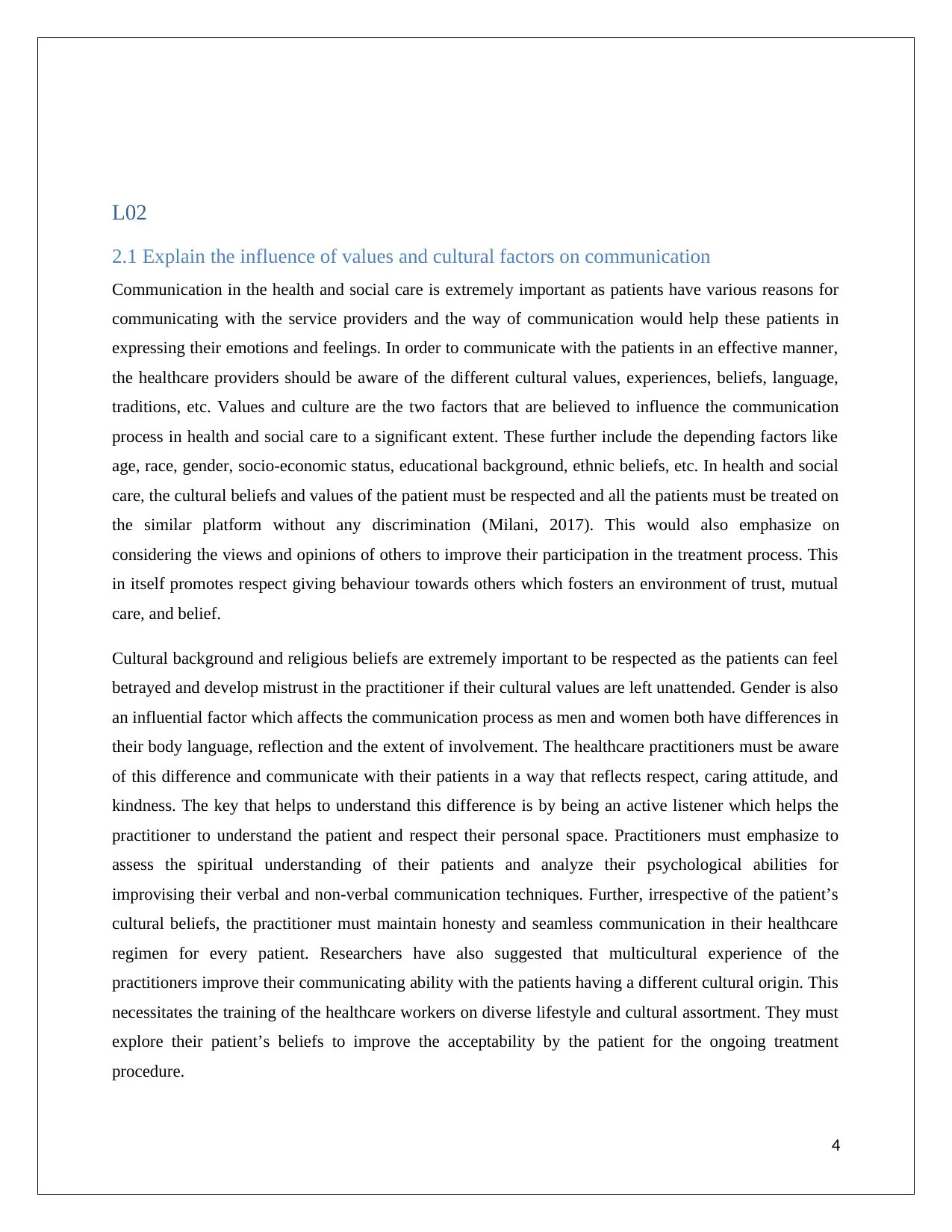
L02
2.1 Explain the influence of values and cultural factors on communication
Communication in the health and social care is extremely important as patients have various reasons for
communicating with the service providers and the way of communication would help these patients in
expressing their emotions and feelings. In order to communicate with the patients in an effective manner,
the healthcare providers should be aware of the different cultural values, experiences, beliefs, language,
traditions, etc. Values and culture are the two factors that are believed to influence the communication
process in health and social care to a significant extent. These further include the depending factors like
age, race, gender, socio-economic status, educational background, ethnic beliefs, etc. In health and social
care, the cultural beliefs and values of the patient must be respected and all the patients must be treated on
the similar platform without any discrimination (Milani, 2017). This would also emphasize on
considering the views and opinions of others to improve their participation in the treatment process. This
in itself promotes respect giving behaviour towards others which fosters an environment of trust, mutual
care, and belief.
Cultural background and religious beliefs are extremely important to be respected as the patients can feel
betrayed and develop mistrust in the practitioner if their cultural values are left unattended. Gender is also
an influential factor which affects the communication process as men and women both have differences in
their body language, reflection and the extent of involvement. The healthcare practitioners must be aware
of this difference and communicate with their patients in a way that reflects respect, caring attitude, and
kindness. The key that helps to understand this difference is by being an active listener which helps the
practitioner to understand the patient and respect their personal space. Practitioners must emphasize to
assess the spiritual understanding of their patients and analyze their psychological abilities for
improvising their verbal and non-verbal communication techniques. Further, irrespective of the patient’s
cultural beliefs, the practitioner must maintain honesty and seamless communication in their healthcare
regimen for every patient. Researchers have also suggested that multicultural experience of the
practitioners improve their communicating ability with the patients having a different cultural origin. This
necessitates the training of the healthcare workers on diverse lifestyle and cultural assortment. They must
explore their patient’s beliefs to improve the acceptability by the patient for the ongoing treatment
procedure.
4
2.1 Explain the influence of values and cultural factors on communication
Communication in the health and social care is extremely important as patients have various reasons for
communicating with the service providers and the way of communication would help these patients in
expressing their emotions and feelings. In order to communicate with the patients in an effective manner,
the healthcare providers should be aware of the different cultural values, experiences, beliefs, language,
traditions, etc. Values and culture are the two factors that are believed to influence the communication
process in health and social care to a significant extent. These further include the depending factors like
age, race, gender, socio-economic status, educational background, ethnic beliefs, etc. In health and social
care, the cultural beliefs and values of the patient must be respected and all the patients must be treated on
the similar platform without any discrimination (Milani, 2017). This would also emphasize on
considering the views and opinions of others to improve their participation in the treatment process. This
in itself promotes respect giving behaviour towards others which fosters an environment of trust, mutual
care, and belief.
Cultural background and religious beliefs are extremely important to be respected as the patients can feel
betrayed and develop mistrust in the practitioner if their cultural values are left unattended. Gender is also
an influential factor which affects the communication process as men and women both have differences in
their body language, reflection and the extent of involvement. The healthcare practitioners must be aware
of this difference and communicate with their patients in a way that reflects respect, caring attitude, and
kindness. The key that helps to understand this difference is by being an active listener which helps the
practitioner to understand the patient and respect their personal space. Practitioners must emphasize to
assess the spiritual understanding of their patients and analyze their psychological abilities for
improvising their verbal and non-verbal communication techniques. Further, irrespective of the patient’s
cultural beliefs, the practitioner must maintain honesty and seamless communication in their healthcare
regimen for every patient. Researchers have also suggested that multicultural experience of the
practitioners improve their communicating ability with the patients having a different cultural origin. This
necessitates the training of the healthcare workers on diverse lifestyle and cultural assortment. They must
explore their patient’s beliefs to improve the acceptability by the patient for the ongoing treatment
procedure.
4
Secure Best Marks with AI Grader
Need help grading? Try our AI Grader for instant feedback on your assignments.
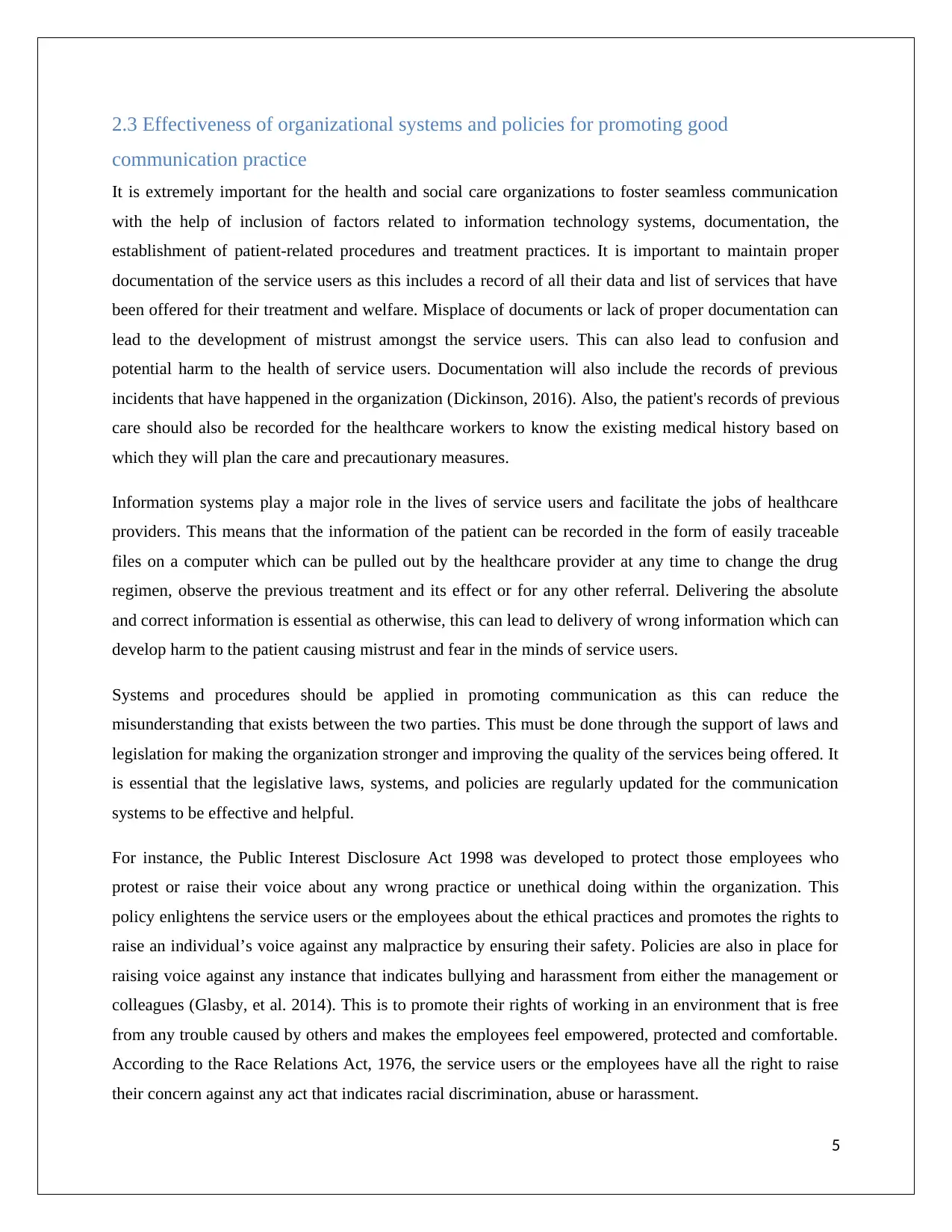
2.3 Effectiveness of organizational systems and policies for promoting good
communication practice
It is extremely important for the health and social care organizations to foster seamless communication
with the help of inclusion of factors related to information technology systems, documentation, the
establishment of patient-related procedures and treatment practices. It is important to maintain proper
documentation of the service users as this includes a record of all their data and list of services that have
been offered for their treatment and welfare. Misplace of documents or lack of proper documentation can
lead to the development of mistrust amongst the service users. This can also lead to confusion and
potential harm to the health of service users. Documentation will also include the records of previous
incidents that have happened in the organization (Dickinson, 2016). Also, the patient's records of previous
care should also be recorded for the healthcare workers to know the existing medical history based on
which they will plan the care and precautionary measures.
Information systems play a major role in the lives of service users and facilitate the jobs of healthcare
providers. This means that the information of the patient can be recorded in the form of easily traceable
files on a computer which can be pulled out by the healthcare provider at any time to change the drug
regimen, observe the previous treatment and its effect or for any other referral. Delivering the absolute
and correct information is essential as otherwise, this can lead to delivery of wrong information which can
develop harm to the patient causing mistrust and fear in the minds of service users.
Systems and procedures should be applied in promoting communication as this can reduce the
misunderstanding that exists between the two parties. This must be done through the support of laws and
legislation for making the organization stronger and improving the quality of the services being offered. It
is essential that the legislative laws, systems, and policies are regularly updated for the communication
systems to be effective and helpful.
For instance, the Public Interest Disclosure Act 1998 was developed to protect those employees who
protest or raise their voice about any wrong practice or unethical doing within the organization. This
policy enlightens the service users or the employees about the ethical practices and promotes the rights to
raise an individual’s voice against any malpractice by ensuring their safety. Policies are also in place for
raising voice against any instance that indicates bullying and harassment from either the management or
colleagues (Glasby, et al. 2014). This is to promote their rights of working in an environment that is free
from any trouble caused by others and makes the employees feel empowered, protected and comfortable.
According to the Race Relations Act, 1976, the service users or the employees have all the right to raise
their concern against any act that indicates racial discrimination, abuse or harassment.
5
communication practice
It is extremely important for the health and social care organizations to foster seamless communication
with the help of inclusion of factors related to information technology systems, documentation, the
establishment of patient-related procedures and treatment practices. It is important to maintain proper
documentation of the service users as this includes a record of all their data and list of services that have
been offered for their treatment and welfare. Misplace of documents or lack of proper documentation can
lead to the development of mistrust amongst the service users. This can also lead to confusion and
potential harm to the health of service users. Documentation will also include the records of previous
incidents that have happened in the organization (Dickinson, 2016). Also, the patient's records of previous
care should also be recorded for the healthcare workers to know the existing medical history based on
which they will plan the care and precautionary measures.
Information systems play a major role in the lives of service users and facilitate the jobs of healthcare
providers. This means that the information of the patient can be recorded in the form of easily traceable
files on a computer which can be pulled out by the healthcare provider at any time to change the drug
regimen, observe the previous treatment and its effect or for any other referral. Delivering the absolute
and correct information is essential as otherwise, this can lead to delivery of wrong information which can
develop harm to the patient causing mistrust and fear in the minds of service users.
Systems and procedures should be applied in promoting communication as this can reduce the
misunderstanding that exists between the two parties. This must be done through the support of laws and
legislation for making the organization stronger and improving the quality of the services being offered. It
is essential that the legislative laws, systems, and policies are regularly updated for the communication
systems to be effective and helpful.
For instance, the Public Interest Disclosure Act 1998 was developed to protect those employees who
protest or raise their voice about any wrong practice or unethical doing within the organization. This
policy enlightens the service users or the employees about the ethical practices and promotes the rights to
raise an individual’s voice against any malpractice by ensuring their safety. Policies are also in place for
raising voice against any instance that indicates bullying and harassment from either the management or
colleagues (Glasby, et al. 2014). This is to promote their rights of working in an environment that is free
from any trouble caused by others and makes the employees feel empowered, protected and comfortable.
According to the Race Relations Act, 1976, the service users or the employees have all the right to raise
their concern against any act that indicates racial discrimination, abuse or harassment.
5
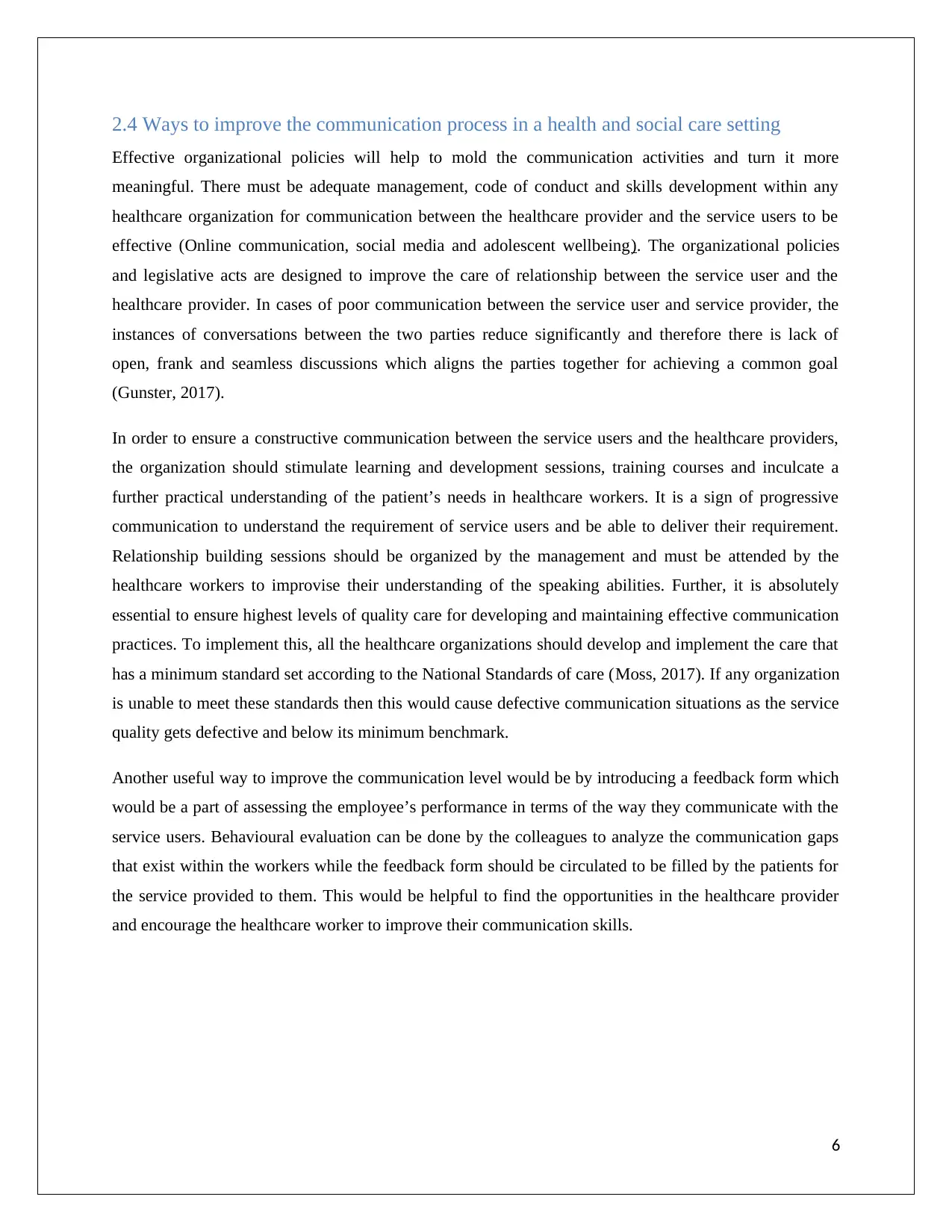
2.4 Ways to improve the communication process in a health and social care setting
Effective organizational policies will help to mold the communication activities and turn it more
meaningful. There must be adequate management, code of conduct and skills development within any
healthcare organization for communication between the healthcare provider and the service users to be
effective (Online communication, social media and adolescent wellbeing). The organizational policies
and legislative acts are designed to improve the care of relationship between the service user and the
healthcare provider. In cases of poor communication between the service user and service provider, the
instances of conversations between the two parties reduce significantly and therefore there is lack of
open, frank and seamless discussions which aligns the parties together for achieving a common goal
(Gunster, 2017).
In order to ensure a constructive communication between the service users and the healthcare providers,
the organization should stimulate learning and development sessions, training courses and inculcate a
further practical understanding of the patient’s needs in healthcare workers. It is a sign of progressive
communication to understand the requirement of service users and be able to deliver their requirement.
Relationship building sessions should be organized by the management and must be attended by the
healthcare workers to improvise their understanding of the speaking abilities. Further, it is absolutely
essential to ensure highest levels of quality care for developing and maintaining effective communication
practices. To implement this, all the healthcare organizations should develop and implement the care that
has a minimum standard set according to the National Standards of care (Moss, 2017). If any organization
is unable to meet these standards then this would cause defective communication situations as the service
quality gets defective and below its minimum benchmark.
Another useful way to improve the communication level would be by introducing a feedback form which
would be a part of assessing the employee’s performance in terms of the way they communicate with the
service users. Behavioural evaluation can be done by the colleagues to analyze the communication gaps
that exist within the workers while the feedback form should be circulated to be filled by the patients for
the service provided to them. This would be helpful to find the opportunities in the healthcare provider
and encourage the healthcare worker to improve their communication skills.
6
Effective organizational policies will help to mold the communication activities and turn it more
meaningful. There must be adequate management, code of conduct and skills development within any
healthcare organization for communication between the healthcare provider and the service users to be
effective (Online communication, social media and adolescent wellbeing). The organizational policies
and legislative acts are designed to improve the care of relationship between the service user and the
healthcare provider. In cases of poor communication between the service user and service provider, the
instances of conversations between the two parties reduce significantly and therefore there is lack of
open, frank and seamless discussions which aligns the parties together for achieving a common goal
(Gunster, 2017).
In order to ensure a constructive communication between the service users and the healthcare providers,
the organization should stimulate learning and development sessions, training courses and inculcate a
further practical understanding of the patient’s needs in healthcare workers. It is a sign of progressive
communication to understand the requirement of service users and be able to deliver their requirement.
Relationship building sessions should be organized by the management and must be attended by the
healthcare workers to improvise their understanding of the speaking abilities. Further, it is absolutely
essential to ensure highest levels of quality care for developing and maintaining effective communication
practices. To implement this, all the healthcare organizations should develop and implement the care that
has a minimum standard set according to the National Standards of care (Moss, 2017). If any organization
is unable to meet these standards then this would cause defective communication situations as the service
quality gets defective and below its minimum benchmark.
Another useful way to improve the communication level would be by introducing a feedback form which
would be a part of assessing the employee’s performance in terms of the way they communicate with the
service users. Behavioural evaluation can be done by the colleagues to analyze the communication gaps
that exist within the workers while the feedback form should be circulated to be filled by the patients for
the service provided to them. This would be helpful to find the opportunities in the healthcare provider
and encourage the healthcare worker to improve their communication skills.
6
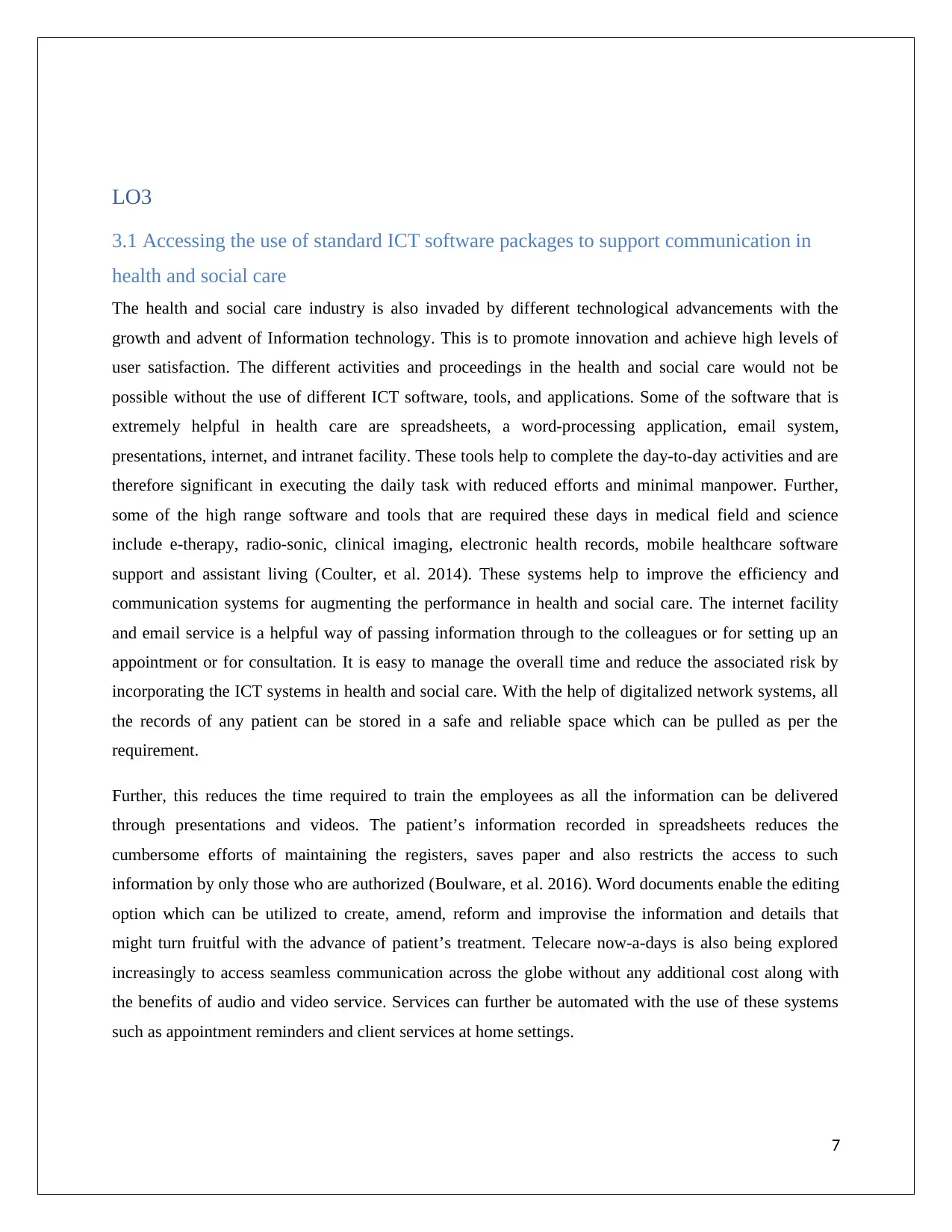
LO3
3.1 Accessing the use of standard ICT software packages to support communication in
health and social care
The health and social care industry is also invaded by different technological advancements with the
growth and advent of Information technology. This is to promote innovation and achieve high levels of
user satisfaction. The different activities and proceedings in the health and social care would not be
possible without the use of different ICT software, tools, and applications. Some of the software that is
extremely helpful in health care are spreadsheets, a word-processing application, email system,
presentations, internet, and intranet facility. These tools help to complete the day-to-day activities and are
therefore significant in executing the daily task with reduced efforts and minimal manpower. Further,
some of the high range software and tools that are required these days in medical field and science
include e-therapy, radio-sonic, clinical imaging, electronic health records, mobile healthcare software
support and assistant living (Coulter, et al. 2014). These systems help to improve the efficiency and
communication systems for augmenting the performance in health and social care. The internet facility
and email service is a helpful way of passing information through to the colleagues or for setting up an
appointment or for consultation. It is easy to manage the overall time and reduce the associated risk by
incorporating the ICT systems in health and social care. With the help of digitalized network systems, all
the records of any patient can be stored in a safe and reliable space which can be pulled as per the
requirement.
Further, this reduces the time required to train the employees as all the information can be delivered
through presentations and videos. The patient’s information recorded in spreadsheets reduces the
cumbersome efforts of maintaining the registers, saves paper and also restricts the access to such
information by only those who are authorized (Boulware, et al. 2016). Word documents enable the editing
option which can be utilized to create, amend, reform and improvise the information and details that
might turn fruitful with the advance of patient’s treatment. Telecare now-a-days is also being explored
increasingly to access seamless communication across the globe without any additional cost along with
the benefits of audio and video service. Services can further be automated with the use of these systems
such as appointment reminders and client services at home settings.
7
3.1 Accessing the use of standard ICT software packages to support communication in
health and social care
The health and social care industry is also invaded by different technological advancements with the
growth and advent of Information technology. This is to promote innovation and achieve high levels of
user satisfaction. The different activities and proceedings in the health and social care would not be
possible without the use of different ICT software, tools, and applications. Some of the software that is
extremely helpful in health care are spreadsheets, a word-processing application, email system,
presentations, internet, and intranet facility. These tools help to complete the day-to-day activities and are
therefore significant in executing the daily task with reduced efforts and minimal manpower. Further,
some of the high range software and tools that are required these days in medical field and science
include e-therapy, radio-sonic, clinical imaging, electronic health records, mobile healthcare software
support and assistant living (Coulter, et al. 2014). These systems help to improve the efficiency and
communication systems for augmenting the performance in health and social care. The internet facility
and email service is a helpful way of passing information through to the colleagues or for setting up an
appointment or for consultation. It is easy to manage the overall time and reduce the associated risk by
incorporating the ICT systems in health and social care. With the help of digitalized network systems, all
the records of any patient can be stored in a safe and reliable space which can be pulled as per the
requirement.
Further, this reduces the time required to train the employees as all the information can be delivered
through presentations and videos. The patient’s information recorded in spreadsheets reduces the
cumbersome efforts of maintaining the registers, saves paper and also restricts the access to such
information by only those who are authorized (Boulware, et al. 2016). Word documents enable the editing
option which can be utilized to create, amend, reform and improvise the information and details that
might turn fruitful with the advance of patient’s treatment. Telecare now-a-days is also being explored
increasingly to access seamless communication across the globe without any additional cost along with
the benefits of audio and video service. Services can further be automated with the use of these systems
such as appointment reminders and client services at home settings.
7
Paraphrase This Document
Need a fresh take? Get an instant paraphrase of this document with our AI Paraphraser
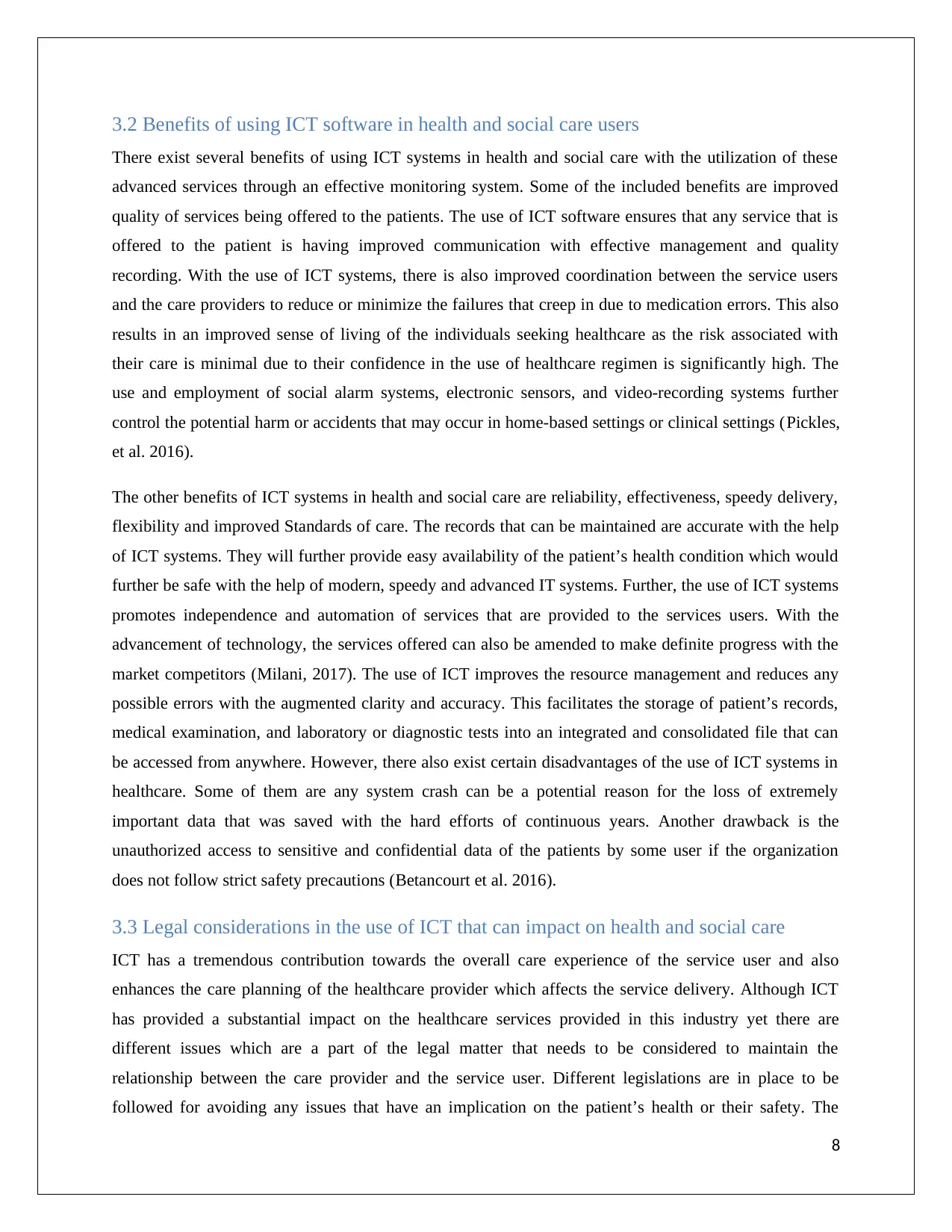
3.2 Benefits of using ICT software in health and social care users
There exist several benefits of using ICT systems in health and social care with the utilization of these
advanced services through an effective monitoring system. Some of the included benefits are improved
quality of services being offered to the patients. The use of ICT software ensures that any service that is
offered to the patient is having improved communication with effective management and quality
recording. With the use of ICT systems, there is also improved coordination between the service users
and the care providers to reduce or minimize the failures that creep in due to medication errors. This also
results in an improved sense of living of the individuals seeking healthcare as the risk associated with
their care is minimal due to their confidence in the use of healthcare regimen is significantly high. The
use and employment of social alarm systems, electronic sensors, and video-recording systems further
control the potential harm or accidents that may occur in home-based settings or clinical settings (Pickles,
et al. 2016).
The other benefits of ICT systems in health and social care are reliability, effectiveness, speedy delivery,
flexibility and improved Standards of care. The records that can be maintained are accurate with the help
of ICT systems. They will further provide easy availability of the patient’s health condition which would
further be safe with the help of modern, speedy and advanced IT systems. Further, the use of ICT systems
promotes independence and automation of services that are provided to the services users. With the
advancement of technology, the services offered can also be amended to make definite progress with the
market competitors (Milani, 2017). The use of ICT improves the resource management and reduces any
possible errors with the augmented clarity and accuracy. This facilitates the storage of patient’s records,
medical examination, and laboratory or diagnostic tests into an integrated and consolidated file that can
be accessed from anywhere. However, there also exist certain disadvantages of the use of ICT systems in
healthcare. Some of them are any system crash can be a potential reason for the loss of extremely
important data that was saved with the hard efforts of continuous years. Another drawback is the
unauthorized access to sensitive and confidential data of the patients by some user if the organization
does not follow strict safety precautions (Betancourt et al. 2016).
3.3 Legal considerations in the use of ICT that can impact on health and social care
ICT has a tremendous contribution towards the overall care experience of the service user and also
enhances the care planning of the healthcare provider which affects the service delivery. Although ICT
has provided a substantial impact on the healthcare services provided in this industry yet there are
different issues which are a part of the legal matter that needs to be considered to maintain the
relationship between the care provider and the service user. Different legislations are in place to be
followed for avoiding any issues that have an implication on the patient’s health or their safety. The
8
There exist several benefits of using ICT systems in health and social care with the utilization of these
advanced services through an effective monitoring system. Some of the included benefits are improved
quality of services being offered to the patients. The use of ICT software ensures that any service that is
offered to the patient is having improved communication with effective management and quality
recording. With the use of ICT systems, there is also improved coordination between the service users
and the care providers to reduce or minimize the failures that creep in due to medication errors. This also
results in an improved sense of living of the individuals seeking healthcare as the risk associated with
their care is minimal due to their confidence in the use of healthcare regimen is significantly high. The
use and employment of social alarm systems, electronic sensors, and video-recording systems further
control the potential harm or accidents that may occur in home-based settings or clinical settings (Pickles,
et al. 2016).
The other benefits of ICT systems in health and social care are reliability, effectiveness, speedy delivery,
flexibility and improved Standards of care. The records that can be maintained are accurate with the help
of ICT systems. They will further provide easy availability of the patient’s health condition which would
further be safe with the help of modern, speedy and advanced IT systems. Further, the use of ICT systems
promotes independence and automation of services that are provided to the services users. With the
advancement of technology, the services offered can also be amended to make definite progress with the
market competitors (Milani, 2017). The use of ICT improves the resource management and reduces any
possible errors with the augmented clarity and accuracy. This facilitates the storage of patient’s records,
medical examination, and laboratory or diagnostic tests into an integrated and consolidated file that can
be accessed from anywhere. However, there also exist certain disadvantages of the use of ICT systems in
healthcare. Some of them are any system crash can be a potential reason for the loss of extremely
important data that was saved with the hard efforts of continuous years. Another drawback is the
unauthorized access to sensitive and confidential data of the patients by some user if the organization
does not follow strict safety precautions (Betancourt et al. 2016).
3.3 Legal considerations in the use of ICT that can impact on health and social care
ICT has a tremendous contribution towards the overall care experience of the service user and also
enhances the care planning of the healthcare provider which affects the service delivery. Although ICT
has provided a substantial impact on the healthcare services provided in this industry yet there are
different issues which are a part of the legal matter that needs to be considered to maintain the
relationship between the care provider and the service user. Different legislations are in place to be
followed for avoiding any issues that have an implication on the patient’s health or their safety. The
8
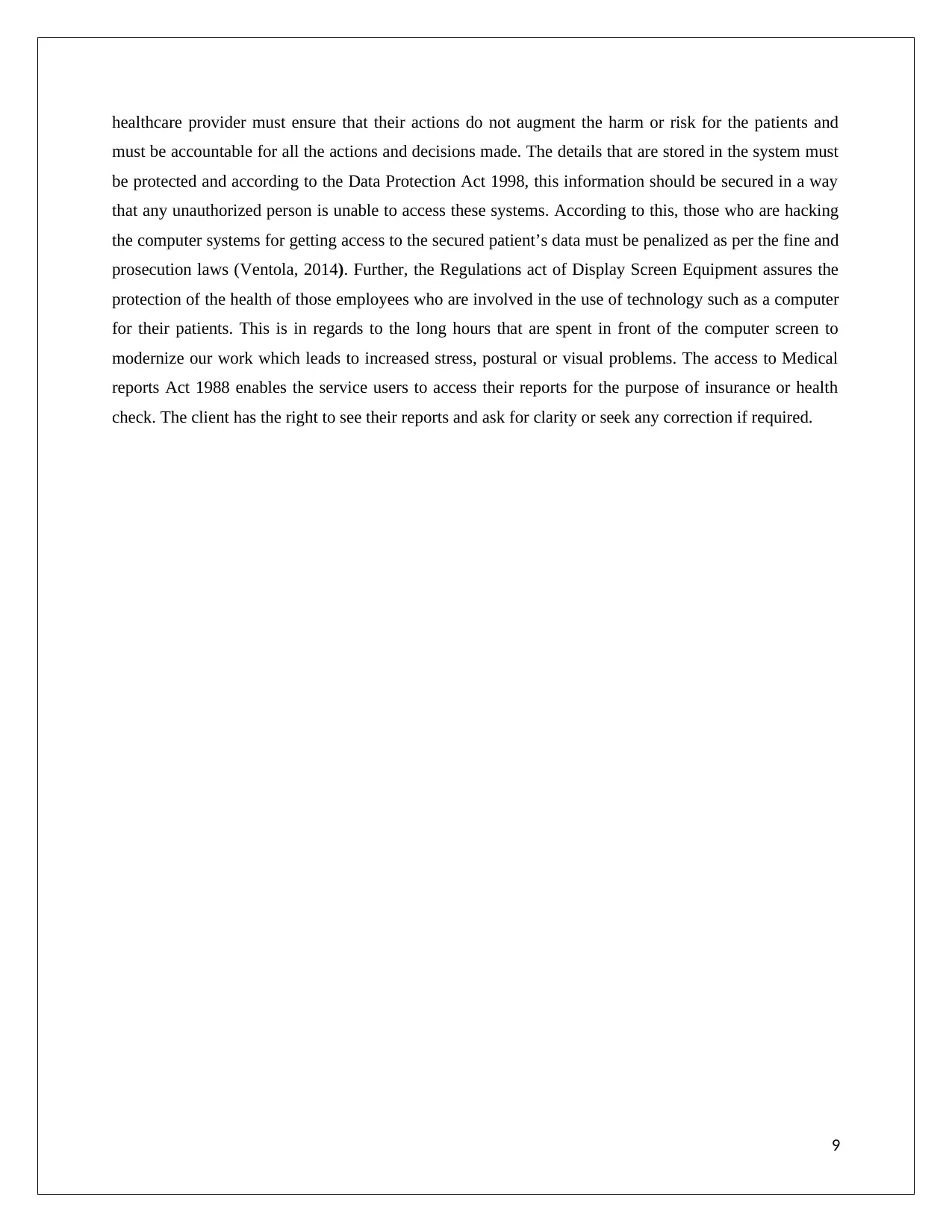
healthcare provider must ensure that their actions do not augment the harm or risk for the patients and
must be accountable for all the actions and decisions made. The details that are stored in the system must
be protected and according to the Data Protection Act 1998, this information should be secured in a way
that any unauthorized person is unable to access these systems. According to this, those who are hacking
the computer systems for getting access to the secured patient’s data must be penalized as per the fine and
prosecution laws (Ventola, 2014). Further, the Regulations act of Display Screen Equipment assures the
protection of the health of those employees who are involved in the use of technology such as a computer
for their patients. This is in regards to the long hours that are spent in front of the computer screen to
modernize our work which leads to increased stress, postural or visual problems. The access to Medical
reports Act 1988 enables the service users to access their reports for the purpose of insurance or health
check. The client has the right to see their reports and ask for clarity or seek any correction if required.
9
must be accountable for all the actions and decisions made. The details that are stored in the system must
be protected and according to the Data Protection Act 1998, this information should be secured in a way
that any unauthorized person is unable to access these systems. According to this, those who are hacking
the computer systems for getting access to the secured patient’s data must be penalized as per the fine and
prosecution laws (Ventola, 2014). Further, the Regulations act of Display Screen Equipment assures the
protection of the health of those employees who are involved in the use of technology such as a computer
for their patients. This is in regards to the long hours that are spent in front of the computer screen to
modernize our work which leads to increased stress, postural or visual problems. The access to Medical
reports Act 1988 enables the service users to access their reports for the purpose of insurance or health
check. The client has the right to see their reports and ask for clarity or seek any correction if required.
9
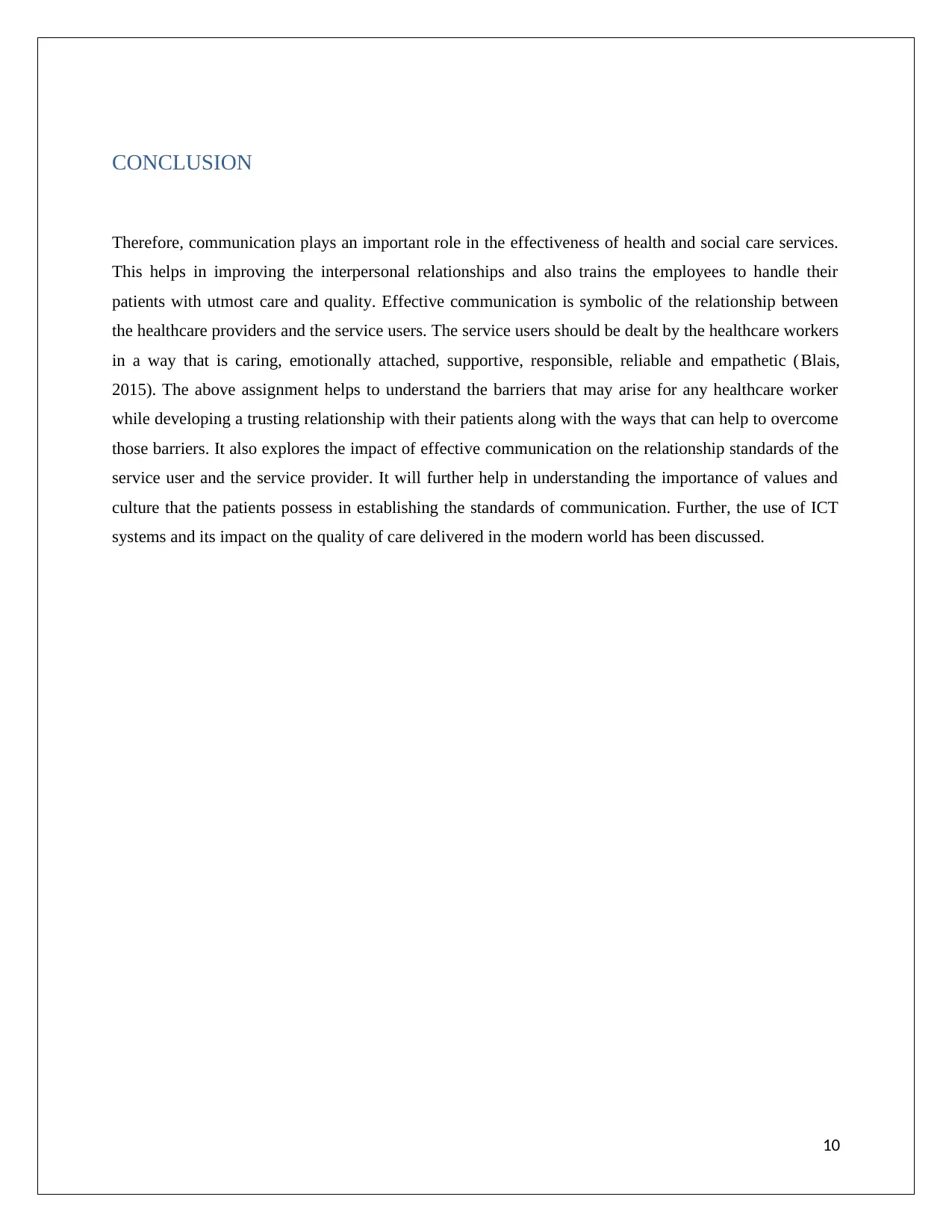
CONCLUSION
Therefore, communication plays an important role in the effectiveness of health and social care services.
This helps in improving the interpersonal relationships and also trains the employees to handle their
patients with utmost care and quality. Effective communication is symbolic of the relationship between
the healthcare providers and the service users. The service users should be dealt by the healthcare workers
in a way that is caring, emotionally attached, supportive, responsible, reliable and empathetic ( Blais,
2015). The above assignment helps to understand the barriers that may arise for any healthcare worker
while developing a trusting relationship with their patients along with the ways that can help to overcome
those barriers. It also explores the impact of effective communication on the relationship standards of the
service user and the service provider. It will further help in understanding the importance of values and
culture that the patients possess in establishing the standards of communication. Further, the use of ICT
systems and its impact on the quality of care delivered in the modern world has been discussed.
10
Therefore, communication plays an important role in the effectiveness of health and social care services.
This helps in improving the interpersonal relationships and also trains the employees to handle their
patients with utmost care and quality. Effective communication is symbolic of the relationship between
the healthcare providers and the service users. The service users should be dealt by the healthcare workers
in a way that is caring, emotionally attached, supportive, responsible, reliable and empathetic ( Blais,
2015). The above assignment helps to understand the barriers that may arise for any healthcare worker
while developing a trusting relationship with their patients along with the ways that can help to overcome
those barriers. It also explores the impact of effective communication on the relationship standards of the
service user and the service provider. It will further help in understanding the importance of values and
culture that the patients possess in establishing the standards of communication. Further, the use of ICT
systems and its impact on the quality of care delivered in the modern world has been discussed.
10
Secure Best Marks with AI Grader
Need help grading? Try our AI Grader for instant feedback on your assignments.
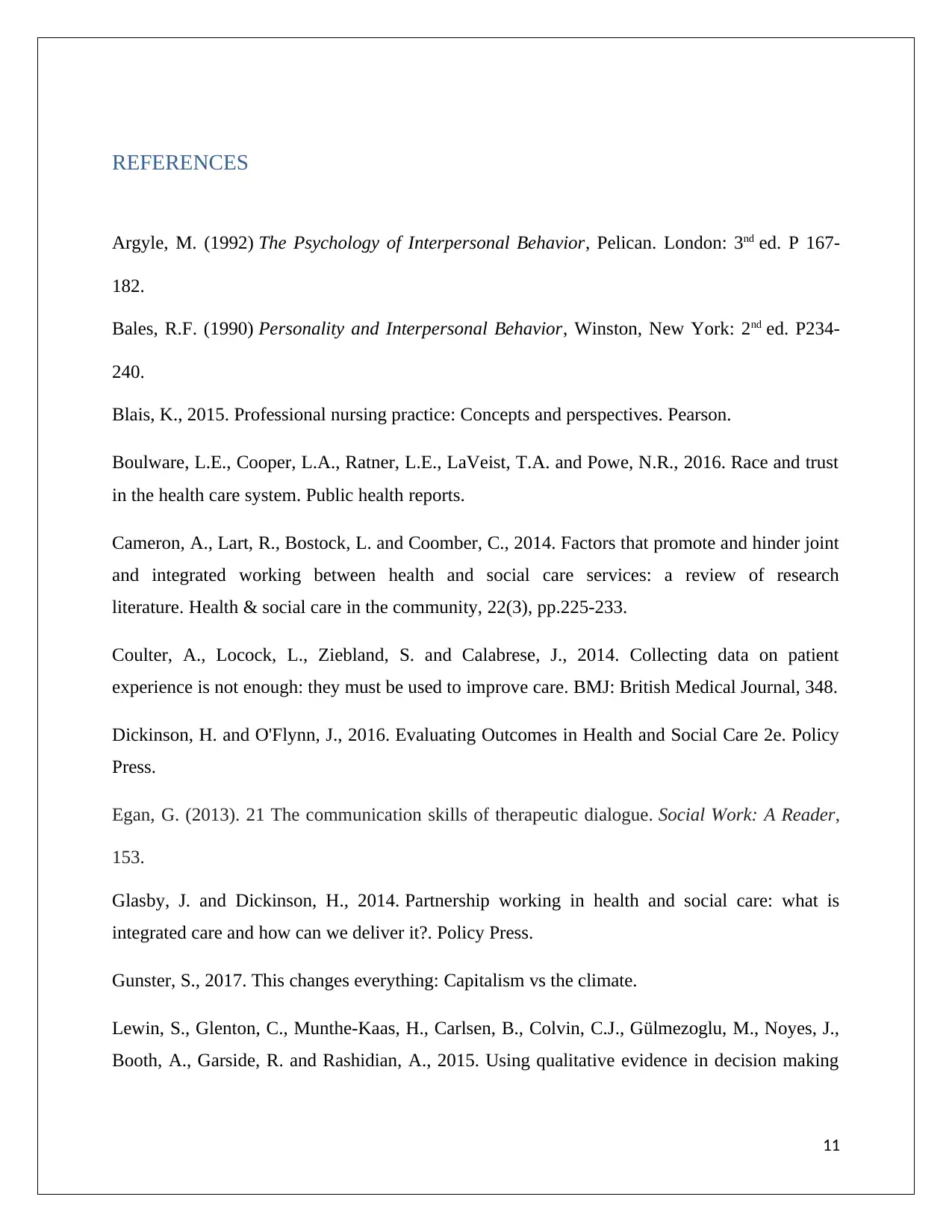
REFERENCES
Argyle, M. (1992) The Psychology of Interpersonal Behavior, Pelican. London: 3nd ed. P 167-
182.
Bales, R.F. (1990) Personality and Interpersonal Behavior, Winston, New York: 2nd ed. P234-
240.
Blais, K., 2015. Professional nursing practice: Concepts and perspectives. Pearson.
Boulware, L.E., Cooper, L.A., Ratner, L.E., LaVeist, T.A. and Powe, N.R., 2016. Race and trust
in the health care system. Public health reports.
Cameron, A., Lart, R., Bostock, L. and Coomber, C., 2014. Factors that promote and hinder joint
and integrated working between health and social care services: a review of research
literature. Health & social care in the community, 22(3), pp.225-233.
Coulter, A., Locock, L., Ziebland, S. and Calabrese, J., 2014. Collecting data on patient
experience is not enough: they must be used to improve care. BMJ: British Medical Journal, 348.
Dickinson, H. and O'Flynn, J., 2016. Evaluating Outcomes in Health and Social Care 2e. Policy
Press.
Egan, G. (2013). 21 The communication skills of therapeutic dialogue. Social Work: A Reader,
153.
Glasby, J. and Dickinson, H., 2014. Partnership working in health and social care: what is
integrated care and how can we deliver it?. Policy Press.
Gunster, S., 2017. This changes everything: Capitalism vs the climate.
Lewin, S., Glenton, C., Munthe-Kaas, H., Carlsen, B., Colvin, C.J., Gülmezoglu, M., Noyes, J.,
Booth, A., Garside, R. and Rashidian, A., 2015. Using qualitative evidence in decision making
11
Argyle, M. (1992) The Psychology of Interpersonal Behavior, Pelican. London: 3nd ed. P 167-
182.
Bales, R.F. (1990) Personality and Interpersonal Behavior, Winston, New York: 2nd ed. P234-
240.
Blais, K., 2015. Professional nursing practice: Concepts and perspectives. Pearson.
Boulware, L.E., Cooper, L.A., Ratner, L.E., LaVeist, T.A. and Powe, N.R., 2016. Race and trust
in the health care system. Public health reports.
Cameron, A., Lart, R., Bostock, L. and Coomber, C., 2014. Factors that promote and hinder joint
and integrated working between health and social care services: a review of research
literature. Health & social care in the community, 22(3), pp.225-233.
Coulter, A., Locock, L., Ziebland, S. and Calabrese, J., 2014. Collecting data on patient
experience is not enough: they must be used to improve care. BMJ: British Medical Journal, 348.
Dickinson, H. and O'Flynn, J., 2016. Evaluating Outcomes in Health and Social Care 2e. Policy
Press.
Egan, G. (2013). 21 The communication skills of therapeutic dialogue. Social Work: A Reader,
153.
Glasby, J. and Dickinson, H., 2014. Partnership working in health and social care: what is
integrated care and how can we deliver it?. Policy Press.
Gunster, S., 2017. This changes everything: Capitalism vs the climate.
Lewin, S., Glenton, C., Munthe-Kaas, H., Carlsen, B., Colvin, C.J., Gülmezoglu, M., Noyes, J.,
Booth, A., Garside, R. and Rashidian, A., 2015. Using qualitative evidence in decision making
11
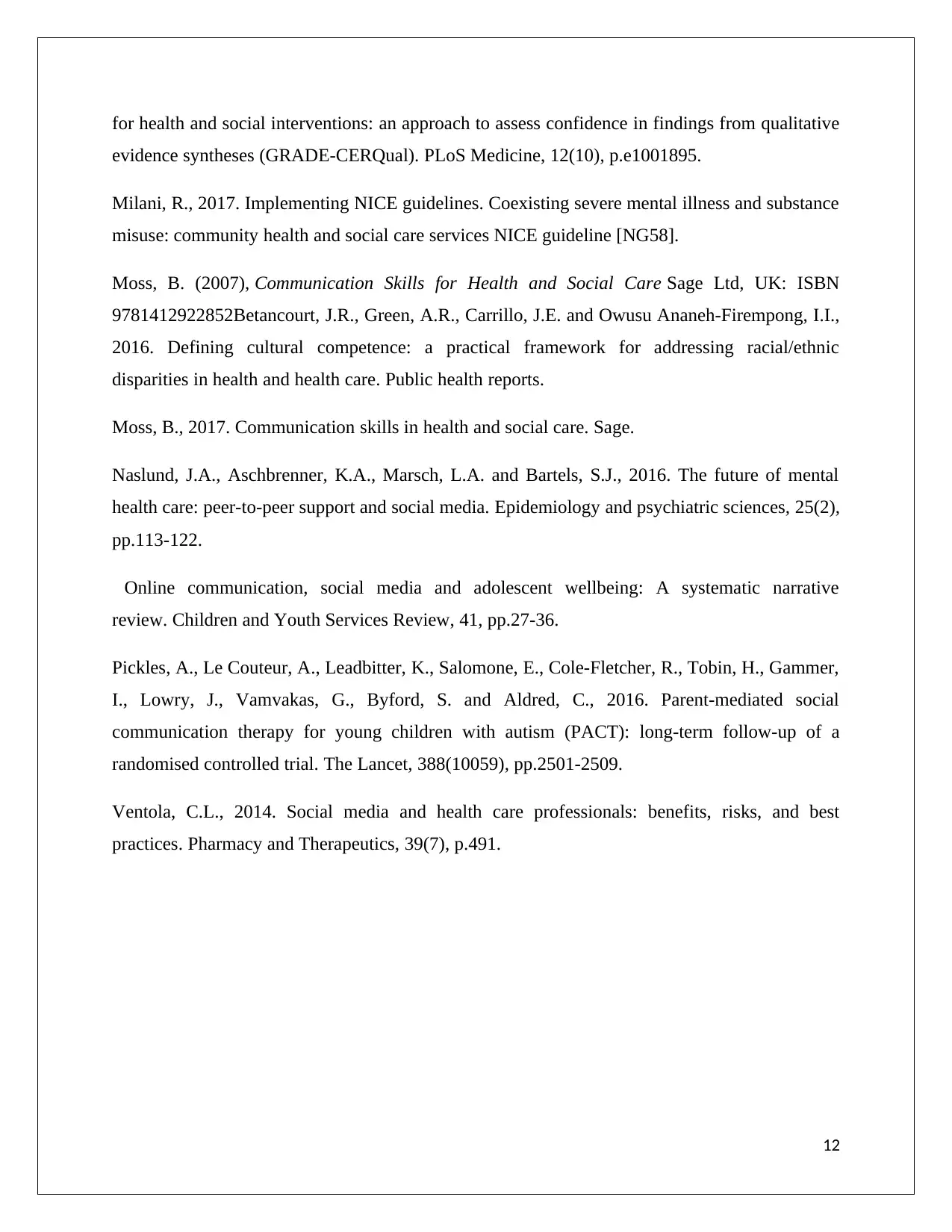
for health and social interventions: an approach to assess confidence in findings from qualitative
evidence syntheses (GRADE-CERQual). PLoS Medicine, 12(10), p.e1001895.
Milani, R., 2017. Implementing NICE guidelines. Coexisting severe mental illness and substance
misuse: community health and social care services NICE guideline [NG58].
Moss, B. (2007), Communication Skills for Health and Social Care Sage Ltd, UK: ISBN
9781412922852Betancourt, J.R., Green, A.R., Carrillo, J.E. and Owusu Ananeh-Firempong, I.I.,
2016. Defining cultural competence: a practical framework for addressing racial/ethnic
disparities in health and health care. Public health reports.
Moss, B., 2017. Communication skills in health and social care. Sage.
Naslund, J.A., Aschbrenner, K.A., Marsch, L.A. and Bartels, S.J., 2016. The future of mental
health care: peer-to-peer support and social media. Epidemiology and psychiatric sciences, 25(2),
pp.113-122.
Online communication, social media and adolescent wellbeing: A systematic narrative
review. Children and Youth Services Review, 41, pp.27-36.
Pickles, A., Le Couteur, A., Leadbitter, K., Salomone, E., Cole-Fletcher, R., Tobin, H., Gammer,
I., Lowry, J., Vamvakas, G., Byford, S. and Aldred, C., 2016. Parent-mediated social
communication therapy for young children with autism (PACT): long-term follow-up of a
randomised controlled trial. The Lancet, 388(10059), pp.2501-2509.
Ventola, C.L., 2014. Social media and health care professionals: benefits, risks, and best
practices. Pharmacy and Therapeutics, 39(7), p.491.
12
evidence syntheses (GRADE-CERQual). PLoS Medicine, 12(10), p.e1001895.
Milani, R., 2017. Implementing NICE guidelines. Coexisting severe mental illness and substance
misuse: community health and social care services NICE guideline [NG58].
Moss, B. (2007), Communication Skills for Health and Social Care Sage Ltd, UK: ISBN
9781412922852Betancourt, J.R., Green, A.R., Carrillo, J.E. and Owusu Ananeh-Firempong, I.I.,
2016. Defining cultural competence: a practical framework for addressing racial/ethnic
disparities in health and health care. Public health reports.
Moss, B., 2017. Communication skills in health and social care. Sage.
Naslund, J.A., Aschbrenner, K.A., Marsch, L.A. and Bartels, S.J., 2016. The future of mental
health care: peer-to-peer support and social media. Epidemiology and psychiatric sciences, 25(2),
pp.113-122.
Online communication, social media and adolescent wellbeing: A systematic narrative
review. Children and Youth Services Review, 41, pp.27-36.
Pickles, A., Le Couteur, A., Leadbitter, K., Salomone, E., Cole-Fletcher, R., Tobin, H., Gammer,
I., Lowry, J., Vamvakas, G., Byford, S. and Aldred, C., 2016. Parent-mediated social
communication therapy for young children with autism (PACT): long-term follow-up of a
randomised controlled trial. The Lancet, 388(10059), pp.2501-2509.
Ventola, C.L., 2014. Social media and health care professionals: benefits, risks, and best
practices. Pharmacy and Therapeutics, 39(7), p.491.
12
1 out of 12
Related Documents
Your All-in-One AI-Powered Toolkit for Academic Success.
+13062052269
info@desklib.com
Available 24*7 on WhatsApp / Email
![[object Object]](/_next/static/media/star-bottom.7253800d.svg)
Unlock your academic potential
© 2024 | Zucol Services PVT LTD | All rights reserved.





